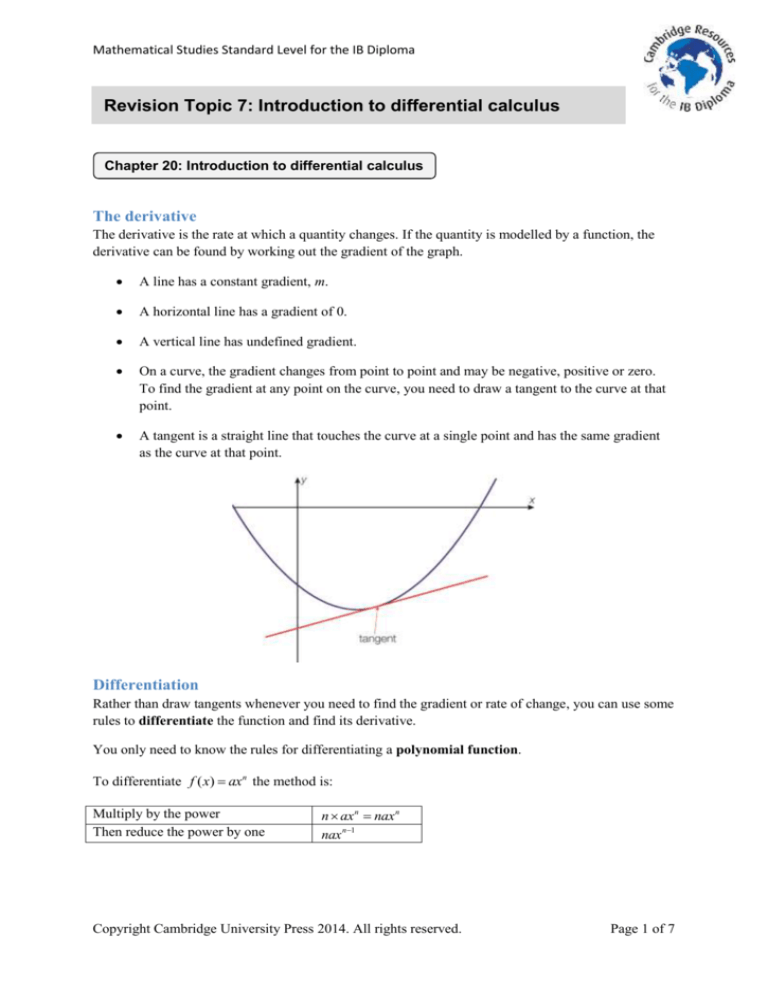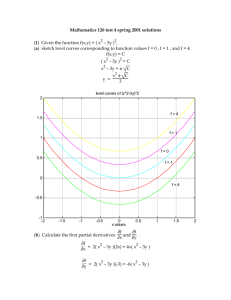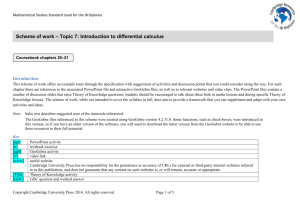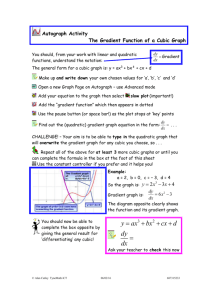
Mathematical Studies Standard Level for the IB Diploma
Revision Topic 7: Introduction to differential calculus
Chapter 20: Introduction to differential calculus
The derivative
The derivative is the rate at which a quantity changes. If the quantity is modelled by a function, the
derivative can be found by working out the gradient of the graph.
A line has a constant gradient, m.
A horizontal line has a gradient of 0.
A vertical line has undefined gradient.
On a curve, the gradient changes from point to point and may be negative, positive or zero.
To find the gradient at any point on the curve, you need to draw a tangent to the curve at that
point.
A tangent is a straight line that touches the curve at a single point and has the same gradient
as the curve at that point.
Differentiation
Rather than draw tangents whenever you need to find the gradient or rate of change, you can use some
rules to differentiate the function and find its derivative.
You only need to know the rules for differentiating a polynomial function.
To differentiate f ( x) axn the method is:
Multiply by the power
Then reduce the power by one
n ax n nax n
nax n 1
Copyright Cambridge University Press 2014. All rights reserved.
Page 1 of 7
Mathematical Studies Standard Level for the IB Diploma
Note that:
If n = 1, the power becomes 0 and, as x0 1 , the derivative will be just a.
If n < 0, the derivative will have an opposite sign to the original function.
If you have a rational function, first rewrite it as a negative power.
You can write the derivative using two different types of notation.
If the function was given as f ( x) axn then you would write f ( x) naxn1
If the function was given as y ax n then you would write
dy
nax n 1
dx
Depending on the context of the question, you may have to write such expressions using different
letters for the variables or a different letter for the function.
If the polynomial is made up of multiple expressions of the form ax n , you differentiate each of them
separately.
For example, if f ( x) 4 x3 2 x 1 , then you differentiate the three parts 4x3 , 2x and +1
separately:
4x3 becomes 3 4 x31 12 x2
2x becomes 1 (2) x11 2 x0 2
+1 becomes 0 (a horizontal function has a gradient of 0)
Putting these back together gives f ( x) 12 x2 2 .
Rates of change
You need to work with contexts and models that have variables different from x and y. The method is
the same, but the letters change. The most commonly seen situations are:
Situation
Height in relation to time
Derivative notation
dh
dt
Volume in relation to radius
dV
dr
Any two variables, say
dA
A in relation to b
db
Copyright Cambridge University Press 2014. All rights reserved.
Page 2 of 7
Mathematical Studies Standard Level for the IB Diploma
Gradient of a curve at a given point
If you are given an x value at which to find the gradient, you should:
Differentiate the function.
Substitute in the value for x and calculate the answer.
Use the notation given in the question to write down the gradient.
For example, given f ( x) 4 x3 2 x 1 , find the gradient when x = 3.
The derivative is f ( x) 12 x2 2 , so you need to work out f (3) 12 (3)2 2 106 .
So the gradient is 106 at this point.
Using your GDC to find the gradient
After plotting the function on your GDC, you can find the value of the derivative at a particular value
of x:
Texas TI-84
Casio fx-9750GII
dy
Access the
function.
dx
Then type in the x value
for which you wish to find
the gradient and then press
[ENTER]/[EXE].
First make sure your GDC is set
up with derivatives on.
Finding x- and y-coordinates from the gradient
You can work out the coordinates of a point on a curve if you know the gradient at that point.
To do this:
Differentiate the function to get the derivative.
Set the derivative equal to the given gradient value.
Solve this equation to find the x-coordinate.
Substitute this value for x into the original function to find the y-coordinate.
Copyright Cambridge University Press 2014. All rights reserved.
Page 3 of 7
Mathematical Studies Standard Level for the IB Diploma
Equation of the tangent at a given point
You should use your GDC to do this.
First, enter the function and draw its graph.
Then do the following to find the equation of the tangent at the given point:
Texas TI-84
Casio fx-9750GII
Access the ‘tangent’
function.
Then put in the x value
of the given point and
press [ENTER]/[EXE].
The equation of the
tangent is displayed on
the screen.
Equation of the normal at a given point
The normal is the line which is perpendicular to the tangent at the given point. If you have a Casio
GDC, there is a ‘normal’ function just below the ‘gradient’ function.
If your GDC is not able to give you the equation of the normal directly, you should first find the
equation of the tangent and then use it to work out the equation of the perpendicular line, as done in
Chapter 14.
Copyright Cambridge University Press 2014. All rights reserved.
Page 4 of 7
Mathematical Studies Standard Level for the IB Diploma
Chapter 21: Stationary points and optimisation
Increasing and decreasing functions
These are defined as follows:
A function is increasing where the gradient is
positive, i.e. f ( x ) 0
A function is decreasing where the gradient is
negative, i.e. f ( x) 0
A point at which the gradient is zero,
i.e. f ( x) 0 , is called a stationary point.
A stationary point where the curve changes
direction from increasing to decreasing or
vice versa is also called a turning point.
Stationary points, maxima and minima
In the above graph there are four stationary points.
All of these are local maximum or minimum points. They don’t give the overall largest or smallest
values for f ( x) , but each gives the largest or smallest value on that portion of the graph.
You may be asked to find local maximum and minimum points of a given function or to determine
whether a particular stationary point is a local maximum or minimum. To work this out, first draw the
graph of the function on your GDC; use the ‘maximum’ and ‘minimum’ functions to find the turning
points. The steps are summarised in the following table.
Copyright Cambridge University Press 2014. All rights reserved.
Page 5 of 7
Mathematical Studies Standard Level for the IB Diploma
Texas TI-84
Casio fx-9750GII
To get the maximum point:
To get the minimum point:
The Texas GDC needs you to tell it which part of the graph you want to analyse.
The Casio GDC will assume you mean a particular point.
Use the arrow keys to move the cursor to an x
value on the left of the turning point; then press
[ENTER]/[EXE].
Now move the cursor to the right of the turning
point and press [ENTER]/[EXE] again.
Then press [ENTER]/[EXE] again, and you
should get the point you want.
Copyright Cambridge University Press 2014. All rights reserved.
Page 6 of 7
Mathematical Studies Standard Level for the IB Diploma
Optimisation
You may be asked to work out the optimal solution for a situation. This means the ‘best’ solution and
will normally be one that gives a maximum or minimum value.
To solve such problems:
Put the function into your GDC.
Draw the graph on your GDC and sketch it on paper to provide an explanation of your
answer.
Find the maximum or minimum points.
Use the differentiation function on your GDC to find rates of change if needed.
Use the table on your GDC to find particular values if needed.
Do not forget to answer the question in the context in which it is set.
Copyright Cambridge University Press 2014. All rights reserved.
Page 7 of 7











